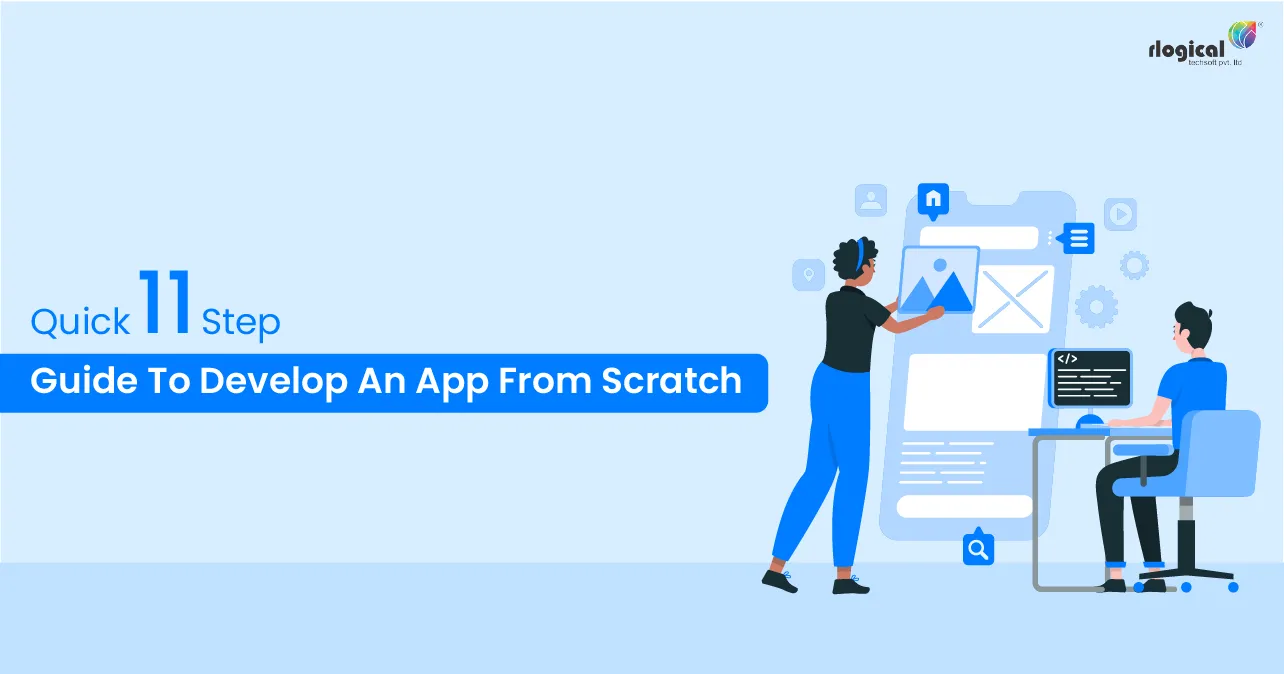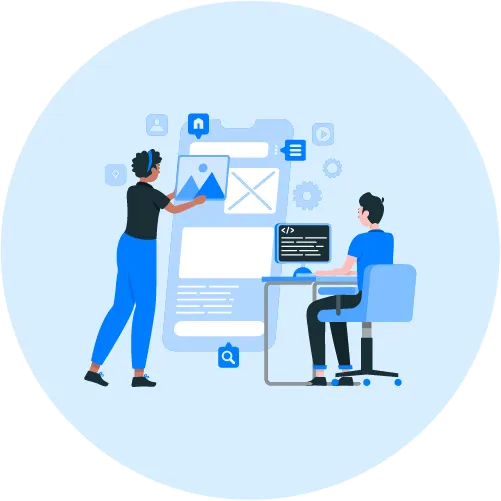
Apps are the tools that people use every day for many utilities. These customized programs are developed to help people with their work and daily tasks. In a way, developers bend the capabilities of technology to create apps. Today, name a purpose, and you will have an app in the store to help you achieve it. The mushrooming of startup culture and the realization of app ideas is a movement that has revolutionized the app development sector.
Today, even children are learning about the basics of app development. App development basics are important to know whether you are a common man or a professional. Realizing an app idea into a functional mobile app is a journey that every app developer has to go through. The development of an app cannot be done blindly. An app is developed with a certain purpose and needs clarity of thought and technology for the best results.
In this blog, the reader will know the basic steps taken for app development followed by a Mobile App developer company. Leading app development agencies take a systematic approach to app development, creating efficient and high-performance final products for public use.
The 11 Step Approach to Mobile App Development
The Mobile App Development process has been divided into steps for better understanding and easy following. The steps to app development are as follows:
1. Ideate and clarify your objectives
As stated earlier, the process of creating an app cannot be initiated blindly. With blind creation, there will be no productive results. Of course, the creation of an app starts from a simple idea. However, since people have thousands of ideas every day, it is important to grasp the scale of your innovative idea and expand it with thought.
The more you focus on your idea, the clearer the implementation part. Mobile apps are created to resolve a common problem. The simpler the solution, the more popular the app is. Therefore, always target a common problem with your idea and expand it to clarify objectives and approaches.
How will the app handle the problem areas? How will the app interact with the user and offer him better service? Ask yourself questions based on which problem you want to solve with the app. Pay attention to how the problem affects people. This research will help you lay down the proper objectives of creating the app. The objectives can be revisited during the mobile app development process to achieve the objectives. By being clear about the objectives of development and use, you create a framework for the app that is filled by its components.
Usually, the objectives of an app can be segregated into the goals of users when they use the app and business goals that the Mobile App Developer wants to achieve by marketing the app. The company needs to analyze and achieve users’ goals so that the business objectives are also consequently achieved.
2. Functionality and features of the app
Once your idea has gained shape into objectives. It is time to visualize the app with its features and basic functionalities. You have to be clear about which features are necessary for the app. The choice of features depends on the user experience the app should extend. The features you include in the portfolio must be what the users need. User surveys and analyses will help you draw a line between necessary and useless features. The goal is to create a well-featured and simple app that provides a great user experience.
List down all the functionalities you want to extend to the user. Similarly, list down the features that will support these functionalities. After this, you have to filter the best and most necessary features to become more streamlined. Another step you can take to create a relevant app is undertaking market research to find out the scope. The market research also provides you with competitor insights to know which features will give your app a competitive edge.
3. Competitor Research
Competitor research has many benefits when you are entering an already established sector with your app. Competitor research gives the app developer a view of what other developer companies are doing in the sector. This will give your development team a view of the market scenario and demand for the app before entering the market.
Competitor research tells you what not to do to make your app just a general one and what to do to make it a novel app that stands out from the crowd. Today, there is an app for everything. Therefore, it is highly instrumental in researching so that your app idea retains its originality and offers novelty in features.
4. Design wireframes
After you have finalized features and functionality and double-checked them with market research, always go ahead with the wireframe. Wireframing brings in individual elements and ideas to create a complete framework for the app’s features and display. The wireframe is necessary to create an app skeleton before adding more features and details. Designing starts with visualizing. Thus, the developer has to sit with the UX design and graphic design team to create the right wireframe for the app. This process consolidates the visual layout and flow of the app so that the app solidifies into a usable platform.
Must Read: Why is UI/UX important for Mobile App Development?
5. Test the wireframe
The layout and visuals of your app are very important because the user interacts with the app. The way an app look is a huge part of its success in user experience. Therefore, before finalizing a wireframe, the wireframe needs to be tested. The primary wireframe has to be tested to suggest improvements and changes. It is important to take the feedback and opinion of your team on the app’s layout. If the team is not satisfied with the results, there is no point in pitching the app to the public.
Moreover, an app wireframe is only the first visualization of the app layout. There will be improvements to make, which become clear with brainstorming sessions. The wireframe can also be pitched to a selected section of the audience segment to improve with real-time feedback from significant sections. Testing helps the company alter the app layout according to public demand and opinion.
6. Choose the development platform
Once the wireframe has been tested and finalized, you need to choose the right development framework and coding language for the app. The development platform and coding language are chosen depending on the app you are developing and the target audience. The development platform also depends on the total cost to develop an app. When the developer is clear about the requirements and objectives of app development, the choice is very easy to make.
7. Develop the app
Once the skeleton of the app and the developing platform are finalized, the development process can go on smoothly. This process includes coding the programs and features and incorporating the features into a single platform. The process includes both front-end and back-end work, which creates the complete app ready for use.
8. Test the app
Before launching it on a full public scale, it is always tested within a certain section or group. Testing of the app happens in phases and indicates performance parameters to improve the app. Just like products, apps also go through testing so that the best quality services reach the final user. Bi phased testing ensures that the app works fine and can handle load efficiently. The testing phases expose bugs and performance gaps for further improvement. An app developer should take up internal and external testing for better results.
9. Launch of the app
Once the app is tested in its complete form, customer feedback is gathered, and the app is improved, the final output can be shared with the public. Thus, the company can launch the app on a large scale. The launch of an app happens on the different app stores of different operating systems. While launching an app sounds easy, it involves many steps. A developer company has to adhere to the guidelines and policies of app stores and optimize their app according to the most recent guidelines for the app to be available in the store.
Must Read: Everything You Should Know About Mobile Application Architecture
10. Promotions and marketing
The launch of an app is not the last step of this development process. To make your app visible and known to people, you must carry out promotional initiatives and marketing. It is very important that the public becomes aware of your app features and creates a positive brand image in its mind.
Promotional initiatives and marketing strategies achieve this goal effectively. Large scale launch of an app needs a solid marketing strategy for building hype around the app. Without marketing, the app will struggle to secure a loyal user base. The most popular apps, however, have strong word-of-mouth marketing.
11. Customer feedback
Even after launch, keeping the portal open for customer feedback is very important. This is because customer temperament and needs, especially technology, shift from time to time. Technology like the app is a dynamic space that has to be improved with periodical feedback. There is always room to improve user experience and features on the app with insights from customers.
These are the steps included in the complete guide to app development from scratch. Apart from consolidating an idea and insight, an app developer has to pay attention to practical aspects of the app. For example, he has to be careful of the cost to develop an app in its final form. As an app developer, you have to always find room for improvement to engage with the app over a long period.
Jatin Panchal
Jatin Panchal is the Founder & Managing Director at Rlogical Techsoft Pvt. Ltd. For more than a decade, he has been fostering the organization's growth in the IT horizons. He has always bestowed personalized approaches on .NET, PHP, Flutter, and Full-Stack web development projects. From startups to large enterprises, he has empowered them to accomplish business goals. By delivering successful industry-driven solutions, he is encouraging the capability of AI, ML, blockchain, and IoT into custom websites and hybrid mobile applications.
Related Blog
Categories
- All
- AI Development Services
- Amazon Web Services (AWS)
- ASP.Net Development
- Azure Web App
- Big Data Analytic
- Customize
- Digital Marketing
- Drupal Development
- E-commerce web development
- Education Mobile App Development
- Enterprise Application
- Event Management App Development
- Fintech
- Fitness App Development
- Food Delievery
- Front-End Development
- Grocery App Development
- Healthcare App Development
- Hire Dedicated Developers
- Hotel Booking App
- IT Industry
- JavaScript Development
- Mobile App Development
- On Demand App Development
- On Demand Healthcare App Development
- PHP Development
- POS Software Development
- Real Estate Mobile App Development
- Retail Business App Development
- Salesforce
- Social Media Development
- Software Development
- Technology
- Transportation App Development
- UI/UX Design
- Web Design
- Web Development
- Web Services
- Web/Data Scraping Services
- WordPress




 Jatin Panchal in Android App Development
Jatin Panchal in Android App Development 





